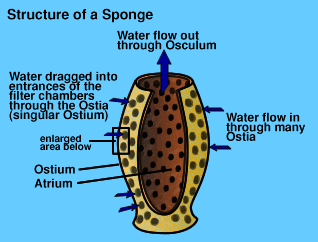|
|
Sponges
 Phylum
Poriphora
Phylum
Poriphora
The Sponges are the simplest of the multicellular animals. They usually attach to hard substrate where water movement is strong.
The body wall has many small pores, called ostea. Sponges are filter feeders. Inflowing water flows in through a series of filter chambers which supply the sponge with unicellular algae and bacteria as food, provides oxygen and removes carbon dioxide in gas exchange, as well as removing excretory products and reproductive gametes.

Click here to see how a sponge gets its food.
References:
Bennett, I. (1987) W.J. Dakin's classic study: Australian Seashores. Angus & Robertson, Sydney.
Davey, K. (1998) A Photographic Guide to Seashore Life of Australia. New Holland, Sydney.
Edgar, G.J. (1997) Australian Marine Life: the plants and animals of temperate waters. Reed Books, Kew.
Quinn, G.P., Wescott, G.C. & Synnot, R.N. (1992) Life on the Rocky Shores of South-Eastern Australia: an illustrated field guide. Victorian National Parks Association, Melbourne.
Marine Research Group of Victoria (1984) Coastal Invertebrates of Victoria: an atlas of selected species. Museum of Victoria, Melbourne.
Niesen, T.M. (1982) The Marine Biology Coloring Book. Barnes & Noble, New York.
Home
Page
Taxonomy
Biogeography
Rocky Shores
Tidal Levels
Intertidal Zonation
Environmental Factors
Biological
Factors
Feeding Relationships
Activities
Glossary
References
 Life
on Australian Seashores
Life
on Australian Seashores
by Keith Davey (C) 2000
Learning Consultant
- Media
The University of Newcastle
email at australian_seashores@hotmail.com
Scientific Consultant: Phil
Colman
site created 01.01.98 : updated 01.04.2000
